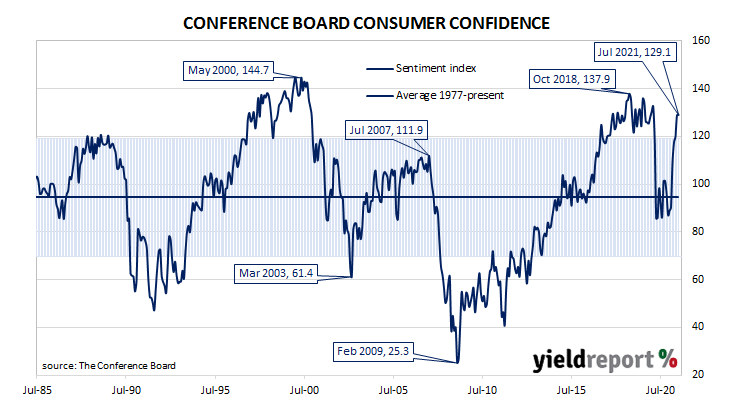Summary: Modest increase in Conference Board Consumer Confidence Index in July; reading well above expected figure; views of present conditions improve, short-term outlook virtually unchanged; Sep quarter growth “off to a strong start”; consumer spending “to support robust economic growth” in second half; “no sign” rising infections dampening confidence.
After the GFC in 2008/09, US consumer confidence clawed its way back to neutral over a number of years and then went from strength to strength until late 2018. Measures of consumer confidence then oscillated within a fairly narrow band at historically high levels until they plunged in early 2020. Subsequent readings then fluctuated around the long-term average until March this year.
The latest Conference Board survey held during the first three weeks of July indicated US consumer confidence has improved a little. July’s Consumer Confidence Index registered 129.1, well above the median consensus figure of 124.0 and slightly higher than June’s final figure of 128.9.
Consumers’ views of present conditions improved while their outlook of the near-future was virtually unchanged. The Present Situation Index rose from 159.6 to 160.3 while the Expectations Index slipped from 108.5 to 108.4.
“Consumers’ appraisal of present-day conditions held steady, suggesting economic growth in Q3 [the September quarter] is off to a strong start,” said Lynn Franco, a senior director at The Conference Board. She also noted “optimism about the short-term outlook didn’t waver” and consumers’ spending intentions had “picked up”. She expects consumer spending “should continue to support robust economic growth in the second half of 2021.”

Longer-term US Treasury bond yields fell on the day. By the close of business, the 10-year Treasury bond yield had lost 6bps to 1.24% and 30-year had shed 4bps to 1.90%. The 2-year yield finished unchanged at 0.20%.
In terms of US Fed policy, expectations of any change in the federal funds rate over the next 12 months remained low. Federal funds futures contracts for July 2022 implied an effective federal funds rate of 0.13%, about 3bps above the current spot rate.
Ray Attrill, NAB’s Head of FX Strategy within its FICC division, said there was “no sign here of rising COVID infections yet dampening consumer spirits.”

